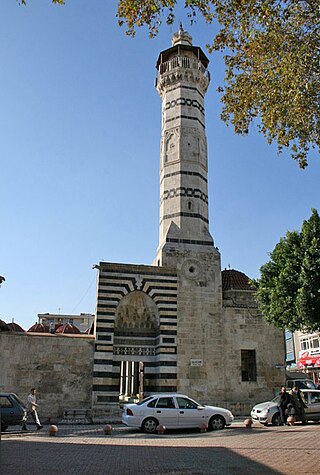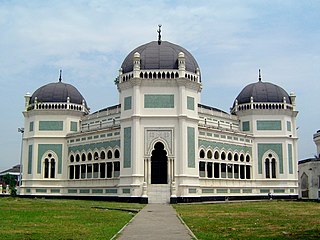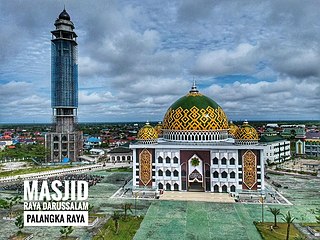
Baiturrahman Grand Mosque is a mosque located in Banda Aceh, Aceh, Indonesia. The Baiturrahman Grand Mosque is a symbol of religion, culture, spirit, strength, struggle, and nationalism of the Acehnese people. The mosque is a landmark in Banda Aceh and has survived the 2004 Indian Ocean earthquake and tsunami.

The Great Mosque of Adana, also known as the Ramazanoglu Mosque Turkish: Ramazanoğlu Camii), is a 16th-century mosque in Adana, Turkey. It forms part of a complex (külliye) that includes a madrasah and a mausoleum (türbe). The buildings are on Kızılay street, next to the Ramazanoğlu Hall.

The Menara Kudus Mosque or Al-Aqsha Mosque is located in Kudus in the Indonesian province of Central Java. Dating from 1549, it is one of the oldest mosques in Indonesia, built at the time of Islam's spread through Java. The mosque preserves the tomb of Sunan Kudus, one of the nine Islamic saints of Java, and is a popular pilgrimage point.

Jama Masjid, also known as Jumah Mosque or Jami' Masjid, is a mosque in Ahmedabad, Gujarat, India. It was built in 1424 during the reign of Ahmad Shah I. The inscription on the central mihrab commemorates the inauguration of the mosque on the 1st Safar A.H. 827 or January 4, 1424 A.D. by Sultan Ahmad Shah I. The mosque lies in the old walled city, and it is situated outside Bhadra Fort area. The old walled city is divided into separate quarters or pols, and the Jami' Masjid is found on the Gandhi Road. Along the south side of the road, the mosque is a short distance beyond the Teen Darwaza or Tripolia Gate.

Grand Mosque of Medan or Masjid Raya Al-Mashun is a mosque located in Medan, Indonesia. The mosque was built in the year 1906 and completed in 1909. In beginning of its establishment, the mosque was a part of the Maimun palace complex. Its architectural style combines Middle Eastern, Indian, and Spanish elements. The mosque has an octagonal shape and has wings to the south, east, north, and west.

Qutb al-Din Shah Masjid, not to be confused with Masjid Qutbuddin Ahmad Shah (1414), is a medieval mosque built in 1449 in Ahmedabad district, Gujarat, India. Although the mosque is not considered a distinctive building by scholars, it exemplifies the progression of the Indo-Islamic architectural style of Ahmedabad in the 15th century.

The Great Mosque of Surakarta is an 18th-century Javanese mosque in Surakarta, Central Java, Indonesia. It is the royal mosque of the Surakarta Sunanate.

The Great Mosque of Sumenep is an 18th-century mosque in Sumenep, Madura. Standing on the alun-alun of Sumenep, it is the largest mosque on Madura Island and a noted landmark of Madura.

The Grand Mosque of Bandung, previously known as the Great Mosque of Bandung, is a mosque in Bandung, the a provincial capital of West Java, Indonesia. The mosque received the status of provincial mosque in West Java Province in 2004. It is located on the east side of the alun-alun of Bandung.

Adhai Din Ka Jhonpra is a historical mosque in the city of Ajmer in Rajasthan, India. It is one of the oldest mosques in India, and the oldest surviving monument in Ajmer.

The Great Mosque of Malang is a mosque located in Malang, Indonesia. The mosque was built in 1890 and completed in 1903, making it one of the oldest mosques in Indonesia. The mosque is square-shaped, constructed with steel, and has a tajug on top. The original building is still maintained today.
Dian Al-Mahri Mosque, also known as Golden Dome Mosque(Masjid Kubah Emas), is a mosque built on the edge of Raya street, Depok City in West Java, Indonesia. In addition to being a place of daily worship for Muslims, this mosque area attracts many locals and tourists because its domes are made of gold. Because of the vastness of the area and its accessibility to the public, this place is often a holiday destination for family or a place to take a rest.

Al-Burdayni Mosque is a mosque in Cairo, Egypt. It is located in Al-Dawoudia, near the Mosque of al-Malika Safiyya. It was built by a wealthy merchant, Kareem al-din al-Bardayni in 1616 during the Ottoman rule. The building is made of stone and has gates erected in 1629 on two sides on the west, right of the fountain. This mosque was built under Ottoman rule after the Ottomans defeated the Mamluks in 1517 and ruled over Egypt until 1867. The mosque is built in Mamluk style not Ottoman style which would have been the prevailing style of choice at the time. This is because Karim al-Din al-Burdayni did not align himself with the cultural practices of the Turks neither the Egyptians.

The Red Mosque of Panjunan is a Javanese mosque located in the village of Panjunan, Cirebon Regency, West Java, Indonesia. This 15th-century mosque with its Hindu architecture typical of Java is one of the oldest mosque in Indonesia.

Mosque architecture in Indonesia refers to the architectural traditions of mosques built in the archipelago of Indonesia. Initial forms of the mosque, for example, were predominantly built in the vernacular Indonesian architectural style mixed with Hindu, Buddhist or Chinese architectural elements, and notably didn't equip orthodox form of Islamic architectural elements such as dome and minaret. Vernacular architectural style varies depending on the island and region.

Ats-Tsauroh Great Mosque of Serang is a congregational mosque in the city of Serang, Banten, Indonesia. Founded in 1870, it is one of the oldest mosques in Banten province.

Darussalam Grand Mosque, Palangka Raya is one of the mosques in Central Kalimantan. This grand mosque is located on George Obos Street in the district of Jekan Raya, Palangka Raya. This mosque is situated within the Islamic Center area of Palangka Raya. This grand mosque is also one of the most important icons of the capital city of Central Kalimantan province.

Al-Istiqlal Great Mosque, Murung Raya is the largest mosque in the entire Murung Raya Regency, Central Kalimantan, Indonesia. This great mosque is located on Jendral Sudirman Street, in the district of Murung, Murung Raya Regency. This great mosque is one of the most popular icons of Murung Raya Regency.

Bibi Ki Masjid, also known as Bibi Saheba Masjid is a mosque in Burhanpur, in the Indian state of Madhya Pradesh. It is listed as a monument of national importance.




























